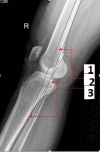Clinico-Radiological Correlation Between Anterior Cruciate Ligament Deficiency and Hyperextension of the Knee Joint: A Prospective Study
- PMID: 38846213
- PMCID: PMC11156214
- DOI: 10.7759/cureus.59817
Clinico-Radiological Correlation Between Anterior Cruciate Ligament Deficiency and Hyperextension of the Knee Joint: A Prospective Study
Abstract
Introduction: The anterior cruciate ligament (ACL) primarily restricts anterior sliding of the tibia over the fixed femur, thereby also postulating to prevent hyperextension of the knee joint. The main objective of our study was to identify the role of the ACL in the prevention of knee hyperextension and to quantify the amount of hyperextension caused by an ACL tear, apart from its well-established role in the prevention of anterior tibial translation on the fixed femur.
Methods: This prospective study was conducted in a tertiary care hospital. Eighty patients with unilateral ACL tears were assessed clinico-radiologically in the preoperative period to quantify the knee hyperextension, which was then compared with the uninjured contralateral knee of the same patient. Posterior tibial slope and notch width index were also assessed to rule out bias in our study.
Results: The mean age of patients in our study was 27.3 years. Out of 80 patients, 70 were male and 10 were female. The Pearson coefficient for clinically and radiologically assessed hyperextension was 0.919 (p-value 0.001) and 0.910 (p-value 0.001), respectively. Posterior tibial slope and notch width index assessment showed Pearson coefficients of -0.018 (p-value 0.887) and -0.068 (p-value 0.547), respectively.
Conclusion: Anterior cruciate ligament complete tear or deficiency produces knee hyperextension, which varies from patient to patient. Though the amount of hyperextension produced is mild (less than five degrees in most patients), it can cause a significant amount of knee instability. Hence, correction of knee hyperextension is crucial while performing ACL reconstruction.
Keywords: acl tear.; hyperlaxity; knee hyperextension; notch width index; posterior tibial slope..
Copyright © 2024, Jarolia et al.
Conflict of interest statement
The authors have declared that no competing interests exist.
Figures







Similar articles
-
[Anterior Cruciate Ligament Tears - Influence on Terminal Extension].Acta Chir Orthop Traumatol Cech. 2018;85(1):22-28. Acta Chir Orthop Traumatol Cech. 2018. PMID: 30257765 Czech.
-
Variations in Knee Kinematics After ACL Injury and After Reconstruction Are Correlated With Bone Shape Differences.Clin Orthop Relat Res. 2017 Oct;475(10):2427-2435. doi: 10.1007/s11999-017-5368-8. Clin Orthop Relat Res. 2017. PMID: 28451863 Free PMC article.
-
Contralateral knee hyperextension is associated with increased anterior tibial translation and fewer meniscal injuries in the anterior cruciate ligament-injured knee.Knee Surg Sports Traumatol Arthrosc. 2018 Oct;26(10):3020-3028. doi: 10.1007/s00167-018-5047-7. Epub 2018 Jul 4. Knee Surg Sports Traumatol Arthrosc. 2018. PMID: 29974175 Free PMC article.
-
Evaluating Differences in Baseline Knee Hyperextension and Postoperative Stiffness Between Patients With Tibial Spine Fracture Versus ACL Tear.Orthop J Sports Med. 2025 Jan 29;13(1):23259671241303747. doi: 10.1177/23259671241303747. eCollection 2025 Jan. Orthop J Sports Med. 2025. PMID: 39886265 Free PMC article.
-
The role of the tibial slope in sustaining and treating anterior cruciate ligament injuries.Knee Surg Sports Traumatol Arthrosc. 2013 Jan;21(1):134-45. doi: 10.1007/s00167-012-1941-6. Epub 2012 Mar 7. Knee Surg Sports Traumatol Arthrosc. 2013. PMID: 22395233 Review.
References
-
- Incidence of anterior cruciate ligament tears and reconstruction: a 21-year population-based study. Sanders TL, Maradit Kremers H, Bryan AJ, et al. Am J Sports Med. 2016;44:1502–1507. - PubMed
-
- Physiological anterior laxity in healthy young females: the effect of knee hyperextension and dominance. Lin HC, Lai WH, Shih YF, Chang CM, Lo CY, Hsu HC. Knee Surg Sports Traumatol Arthrosc. 2009;17:1083–1088. - PubMed
-
- Incidence and trends of anterior cruciate ligament reconstruction in the United States. Mall NA, Chalmers PN, Moric M, Tanaka MJ, Cole BJ, Bach BR Jr, Paletta GA Jr. Am J Sports Med. 2014;42:2363–2370. - PubMed
LinkOut - more resources
Full Text Sources
